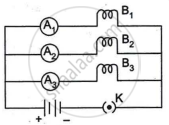Advertisements
Advertisements
Question
Three incandescent bulbs of 100 W each are connected in series in an electric circuit. In another circuit another set of three bulbs of the same wattage are connected in parallel to the same source.
- Will the bulb in the two circuits glow with the same brightness? Justify your answer.
- Now let one bulb in both the circuits get fused. Will the rest of the bulbs continue to glow in each circuit? Give reason.
Solution
 |
 |
| Bulbs connected in series | Bulbs connected in parallel |
Let us assume that the resistance of each bulb is R.
In series:
Current in each bulb = `"V"/(3"R")`
In Parallel:
Net current =`(3"V")/"R"`
Current will get equally divided in three bulb `= "I"/3 = "V"/"R"`
- In a series combination, the potential difference gets divided, whereas, in parallel, the potential difference across each bulb remains full. Hence, in series, bulbs glow with less brightness than bulbs in parallel connection.
- Now, if one bulb gets fused in a series connection, all the other bulbs will stop glowing, whereas in a parallel connection, other bulbs will continue to glow. This is because in a series combination, even a single faulty component breaks the circuit, whereas this does not happen in a parallel circuit.
APPEARS IN
RELATED QUESTIONS
An electric heater is connected to the 230 V mains supply. A current of 8 A flows through the heater.
(a) How much charge flows around the circuit each second?
Why does the connecting cord of an electric heater not glow hot while the heating element does?
Which electric heating device in your home do you think have resistors which control the flow of electricity?
Answer the following question.
Write the mathematical expression for Joule's law of heating.
These days when current in the circuit suddenly increases _______ switches are used.
Which of the following is correct?
A current of 1 A is drawn by a filament of an electric bulb. Number of electrons passing through a cross-section of the filament in 16 seconds would be roughly:
Match the following
| 1. | Bulb | a. | Conductor |
| 2. | Electroplating | b. |
Insulator |
| 3. | Pure water | c. | Heating effect of current |
| 4. | Salt solution | d. | Chemical effect of current |
Explain why fuse wire is always connected in a series arrangement.
An electric iron of resistance 20 Ω draws a current of 5 A. The heat developed in the iron in 30 seconds is ______.
